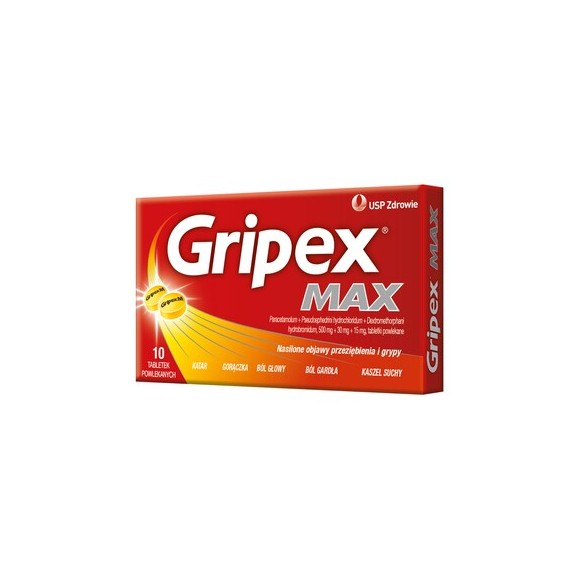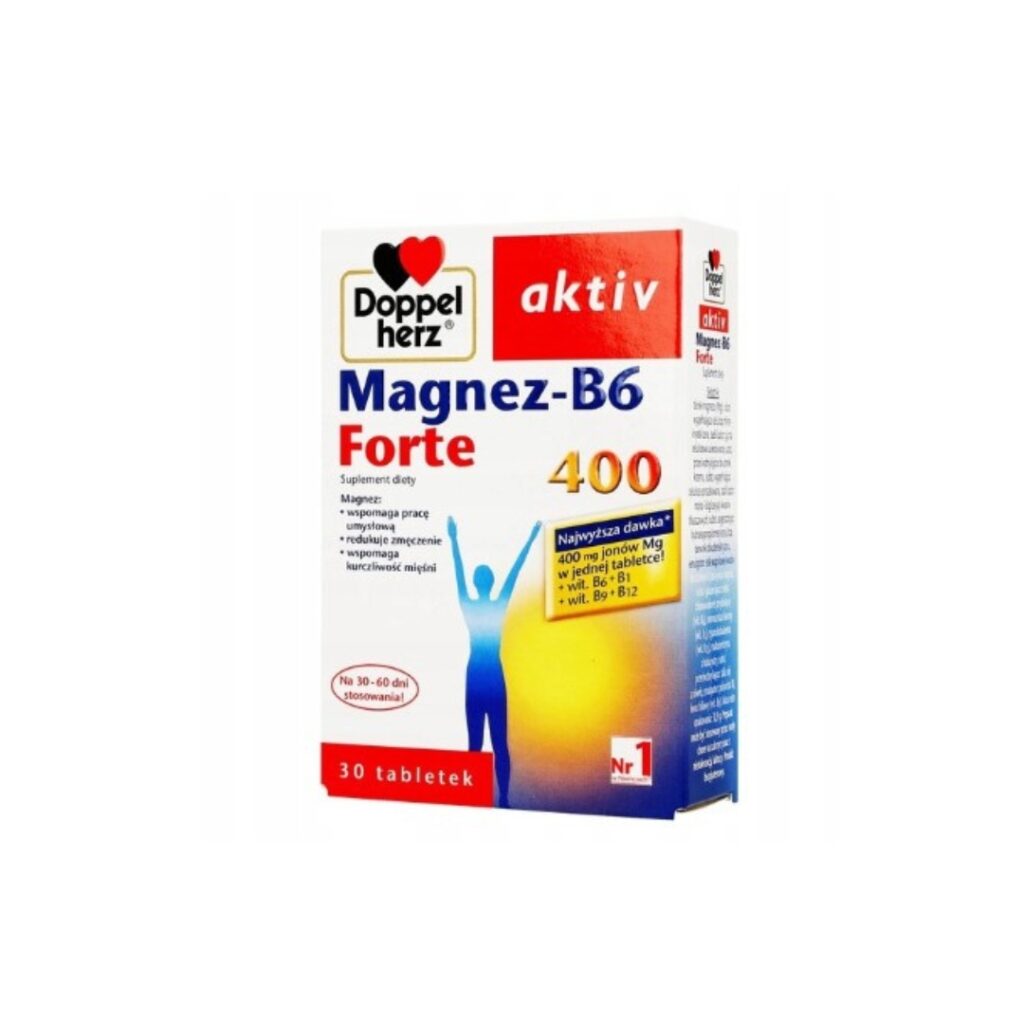Gripex Max Coated Tablets (10 Tablets)
Gripex Max is a multi-component drug. It contains three active substances: paracetamol, pseudoephedrine and dextromethorphan.
- Paracetamol has antipyretic and analgesic properties,
- dextromethorphan has an antitussive effect
- pseudoephedrine restores nasal patency.
Gripex Max is a drug intended for the treatment of adults and adolescents over 12 years of age.
Symptoms
The indication for the use of Gripex Max is the short-term treatment of severe symptoms of colds, flu and flu-like conditions such as: fever, headache, sore throat, muscle and joint pain, runny nose, dry cough.
Active substances: Dextromethorphani hydrobromidum, Paracetamolum, Pseudoephedrini hydrochloridum
Composition
| One film-coated tablet contains | 500 mg paracetamol (Paracetamolum ) |
| 30 mg of pseudoephedrine hydrochloride (Pseudoephedrini hydrochloridum ) | |
| 15 mg of dextromethorphan hydrobromide (Dextromethorphani hydrobromidum ) | |
| The other ingredients are: Tablet core: povidone, microcrystalline cellulose, crospovidone, pregelatinized starch, stearic acid, colloidal anhydrous silica. Coating: (Opadry Yellow 03B12395): hypromellose, titanium dioxide (E 171), tartrazine, lake (E 102), macrogol 400. Printing ink: (Opacode Black S-1-17823): shellac, black iron oxide (E 172) ), N-butyl alcohol, isopropyl alcohol, ammonium hydroxide, propylene glycol. |
Dosage
Always use this medicine exactly as described in the package leaflet or as directed by your doctor or pharmacist. Check with your doctor or pharmacist if you are not sure.
Gripex Max should be used orally.
The recommended dose
Adults and adolescents over 12 years of age: from 1 to 2 tablets, 3-4 times a day.
Do not use more than 8 tablets a day
Use of the drug in children and adolescents
The drug should not be used in children under 12 years of age.
Contraindications
Do not use Gripex Max:
- if you are allergic to paracetamol, pseudoephedrine hydrochloride, dextromethorphan hydrobromide or any of the other ingredients of this medicine;
- if you are taking other medicines containing paracetamol;
- if the patient is taking drugs from the group of MAO inhibitors (drugs used, for example, in depression), as well as within 2 weeks of discontinuing their use;
- if there is a congenital deficiency of glucose-6-phosphate dehydrogenase;
- if you have severe renal or hepatic insufficiency;
- if you have severe hypertension;
- if you have ischemic heart disease;
- patients with alcoholism;
- in patients with bronchial asthma;
- during pregnancy and breastfeeding;
- in children under 12 years of age.
Contents
Yellow, round film-coated tablets imprinted with Gripex M in black on one side. 10 film-coated tablets. PVC / PVDC / Aluminum foil blisters in a cardboard box: 10 pcs. (1 blister of 10 pcs.)
Storage method
15°C-25°C
Manufacturer / Responsible entity
US PHARMACIA
Permission
MZ 10532
Warnings
Talk to your doctor or pharmacist before using Gripex Max.
The use of the drug by people with hepatic insufficiency, alcohol abusing and starving people carries the risk of liver damage. Use with caution in patients with renal failure, arterial hypertension, cardiac arrhythmias, emphysema, increased intraocular pressure, prostatic hyperplasia, hyperthyroidism, diabetes, and those taking anxiolytics, tricyclic antidepressants, other sympathomimetic drugs, i.e. decongestants, appetite suppressants and amphetamine-like psychostimulants. The drug should not be used in chronic cough with expectoration of secretions. The drug should not be used in patients with respiratory failure, bronchial asthma and in patients at risk of respiratory failure. The drug should be used with caution in people taking anticoagulants.
Due to the reported cases of abuse of dextromethorphan, special care should be taken when using Gripex Max in adolescents, young adults and patients abusing drugs or psychoactive substances.
Particular care should be taken in patients who are poor metabolisers with the participation of the enzyme CYP2D6 or those taking substances that inhibit the activity of the enzyme CYP2D6. If you are taking medications that inhibit the activity of the CYP2D6 enzyme, consult your doctor before taking this medication. If it is necessary to use drugs that inhibit the activity of CYP2D6 and dextromethorphan at the same time, the patient must be under close medical supervision. It may be necessary to reduce the dose of dextromethorphan.
Patients who are poor metabolisers of this enzyme and patients who are taking concomitant medications that inhibit CYP2D6 activity may experience increased and / or long-term effects of dextromethorphan. Concomitant use of drugs that strongly inhibit the above-mentioned the enzyme increases the risk of dextromethorphan poisoning manifested by agitation, disorientation, tremors, insomnia, diarrhea and respiratory depression. It can also lead to the development of life-threatening serotonin syndrome (increased heart rate, confusion, profuse sweating, hallucinations, involuntary muscle movements, chills, tremors). If the symptoms described above occur after using Gripex Max, discontinue treatment with this medicine and seek medical advice immediately.
If you develop a fever with generalized skin erythema and pustular rash, stop taking Gripex Max and contact your doctor or seek medical attention immediately.
If symptoms worsen or do not improve after 3 days, please contact your doctor.
Talk to your doctor, even if the above warnings apply to situations in the past.
Pregnancy and lactation
The use of Gripex Max during pregnancy and breastfeeding is contraindicated.
Interactions with other drugs
Paracetamol:
The medicinal product should not be used simultaneously with other drugs containing paracetamol. Drugs that accelerate gastric emptying (e.g. metoclopramide) accelerate the absorption of paracetamol, while drugs that delay gastric emptying (e.g. propantheline) may delay the absorption of paracetamol. The use of paracetamol at the same time as MAO inhibitors and within 2 weeks of stopping treatment with these drugs may cause agitation and fever. Concomitant use of paracetamol with zidovudine (AZT) may increase the toxicity of zidovudine on the bone marrow. Paracetamol may increase the effect of anticoagulants (coumarin derivatives). Concomitant use of paracetamol and drugs that increase hepatic metabolism, such as certain sleeping pills or antiepileptic drugs, e.g. phenobarbital, phenytoin, carbamazepine, as well as rifampicin can lead to liver damage, even at the recommended doses of paracetamol. Drinking alcohol during treatment with paracetamol leads to the formation of a toxic metabolite causing necrosis of the liver cells, which may lead to liver failure. Co-administration with chloramphenicol may result in increased plasma concentrations of chloramphenicol.
Pseudoephedrine:
Concurrent use with albuterol may enhance the vasoconstrictor effect. Do not use simultaneously with amitriptyline and sympathomimetics. Concomitant use with other sympathomimetics, i.e. decongestants, appetite suppressants and amphetamine-like psychostimulants, may lead to an increase in blood pressure.
Ammonium chloride by alkalizing urine increases the reabsorption of pseudoephedrine metabolites in the kidney and extends the duration of its action. Antacids can increase the absorption of pseudoephedrine. MAO inhibitors cause a slower elimination of pseudoephedrine from the body and increase its bioavailability. Pseudoephedrine reduces the effect of antihypertensive drugs and may modify the action of digitalis glycosides. Do not use simultaneously with furazolidine.
Dextromethorphan:
Do not use with MAO inhibitors.
Side effects
Like all medicines, this medicine can cause side effects, although not everybody gets them.
Uncommon side effects (in 1 to 10 out of 1,000 patients taking the medicine):
- fatigue, dizziness;
- nausea and vomiting.
Rare side effects (affects 1 to 10 users in 10,000):
- Type I hypersensitivity reactions: allergic edema (i.e. swelling of the skin and soft tissues, often in the face, e.g. lips, tongue, eyelids), anaphylactic reaction (i.e. dyspnoea, sweating, drop in blood pressure, up to shock symptoms);
- allergic skin reactions, reddening of the skin, rash.
Very rare side effects (less than 1 in 10,000 patients taking the drug):
- disorders of blood cell production: granulocytopenia (decrease in the number of granulocytes in the blood), agranulocytosis (lack of granulocytes in the blood), thrombocytopenia (decrease in the number of blood platelets);
- bronchial asthma attack;
- liver damage most often resulting from overdose;
- renal colic, renal papillary necrosis, acute renal failure, urolithiasis;
- hallucinations.
Side effects for which frequency is unknown (frequency cannot be estimated from the available data):
- somnolence;
- increased heart rate (tachycardia);
- slight increase in blood pressure;
- disorders in urination, urinary retention, especially in patients with an enlarged prostate gland;
- sudden fever, reddening of the skin or numerous small spots (possible symptoms of acute generalized pustular eruption – AGEP) may occur within the first 2 days of using Gripex Max.
If such symptoms occur, stop using Gripex Max and contact your doctor or seek medical attention immediately.




